Sociology: New Zealand Education
VerifiedAdded on 2023/01/18
|15
|3255
|40
AI Summary
This study material discusses the bicultural and multicultural characteristics of the New Zealand primary or secondary education system. It explores the impact of Maori parenting on children's behavior and the role of culture and identity in teaching and learning. The material also highlights the importance of creating a culturally responsive environment and involving whānau in students' learning.
Contribute Materials
Your contribution can guide someone’s learning journey. Share your
documents today.
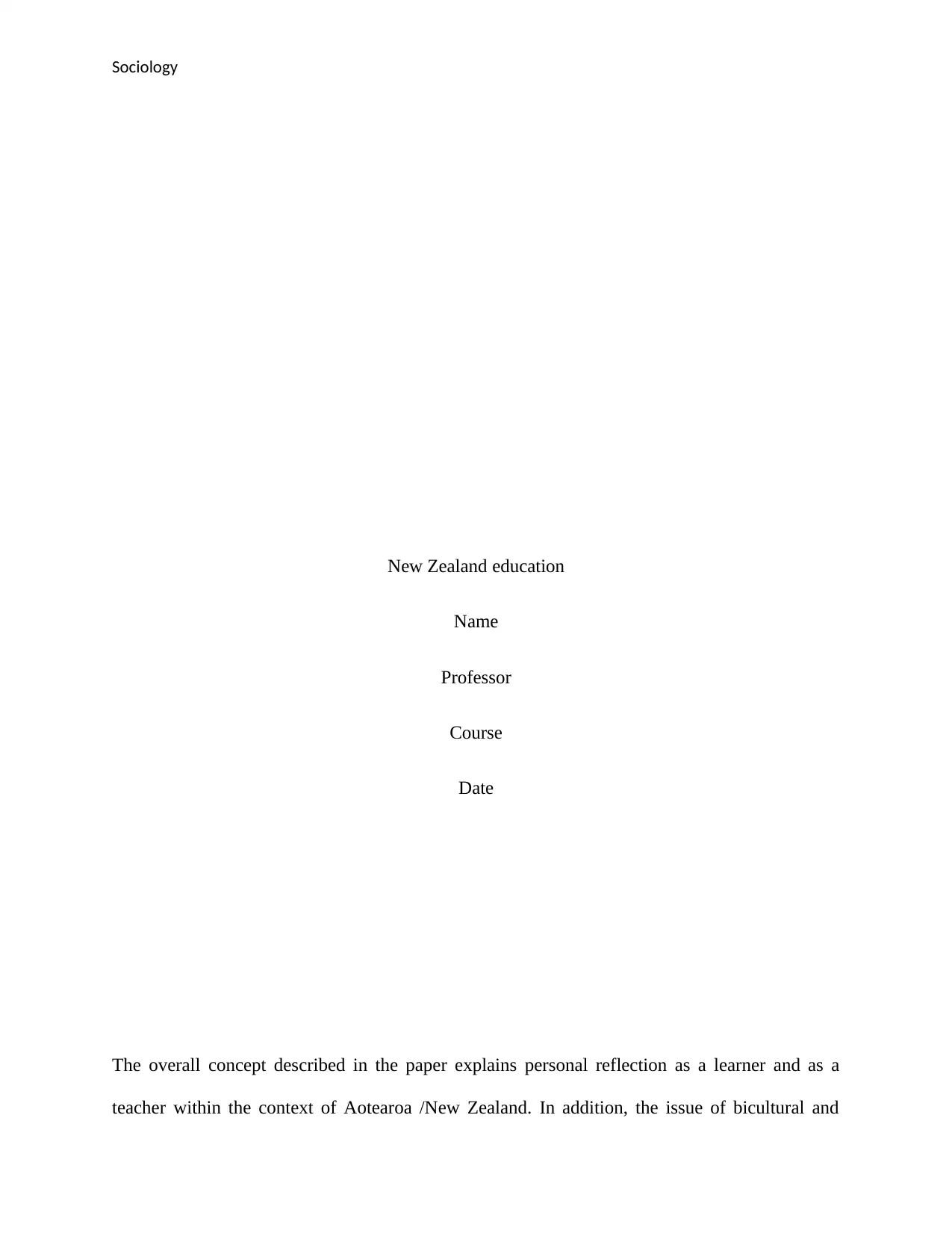
Sociology
New Zealand education
Name
Professor
Course
Date
The overall concept described in the paper explains personal reflection as a learner and as a
teacher within the context of Aotearoa /New Zealand. In addition, the issue of bicultural and
New Zealand education
Name
Professor
Course
Date
The overall concept described in the paper explains personal reflection as a learner and as a
teacher within the context of Aotearoa /New Zealand. In addition, the issue of bicultural and
Secure Best Marks with AI Grader
Need help grading? Try our AI Grader for instant feedback on your assignments.
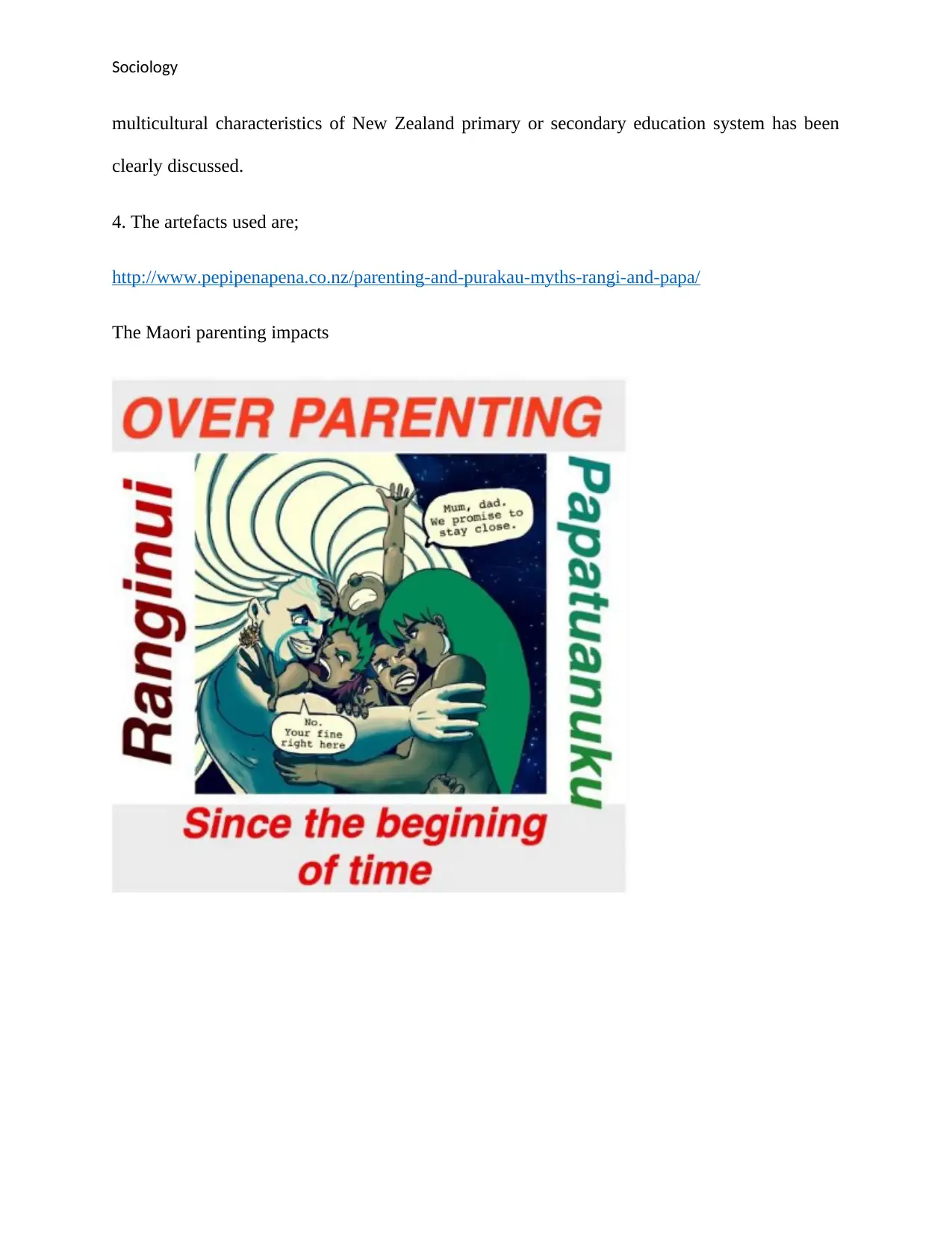
Sociology
multicultural characteristics of New Zealand primary or secondary education system has been
clearly discussed.
4. The artefacts used are;
http://www.pepipenapena.co.nz/parenting-and-purakau-myths-rangi-and-papa/
The Maori parenting impacts
multicultural characteristics of New Zealand primary or secondary education system has been
clearly discussed.
4. The artefacts used are;
http://www.pepipenapena.co.nz/parenting-and-purakau-myths-rangi-and-papa/
The Maori parenting impacts
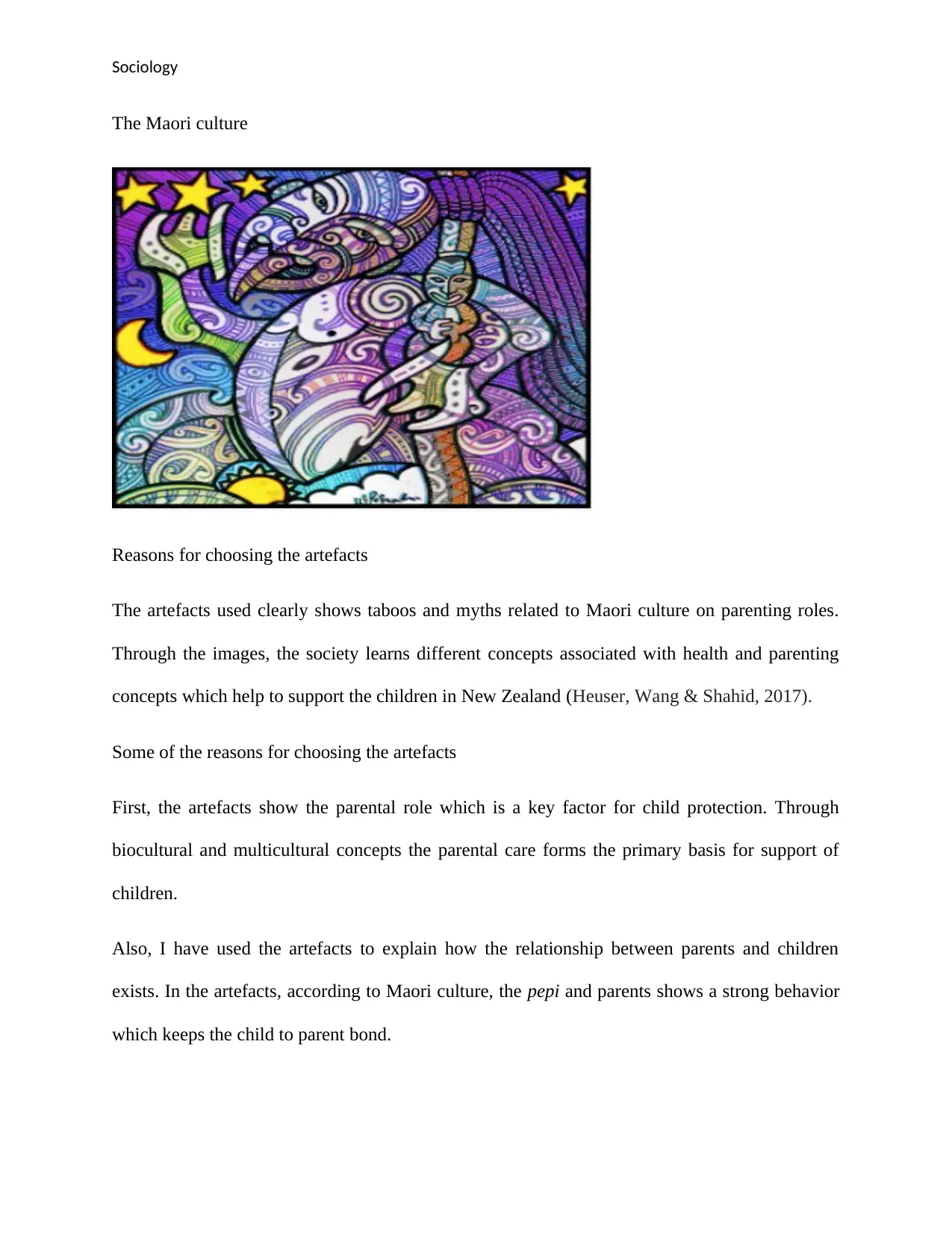
Sociology
The Maori culture
Reasons for choosing the artefacts
The artefacts used clearly shows taboos and myths related to Maori culture on parenting roles.
Through the images, the society learns different concepts associated with health and parenting
concepts which help to support the children in New Zealand (Heuser, Wang & Shahid, 2017).
Some of the reasons for choosing the artefacts
First, the artefacts show the parental role which is a key factor for child protection. Through
biocultural and multicultural concepts the parental care forms the primary basis for support of
children.
Also, I have used the artefacts to explain how the relationship between parents and children
exists. In the artefacts, according to Maori culture, the pepi and parents shows a strong behavior
which keeps the child to parent bond.
The Maori culture
Reasons for choosing the artefacts
The artefacts used clearly shows taboos and myths related to Maori culture on parenting roles.
Through the images, the society learns different concepts associated with health and parenting
concepts which help to support the children in New Zealand (Heuser, Wang & Shahid, 2017).
Some of the reasons for choosing the artefacts
First, the artefacts show the parental role which is a key factor for child protection. Through
biocultural and multicultural concepts the parental care forms the primary basis for support of
children.
Also, I have used the artefacts to explain how the relationship between parents and children
exists. In the artefacts, according to Maori culture, the pepi and parents shows a strong behavior
which keeps the child to parent bond.
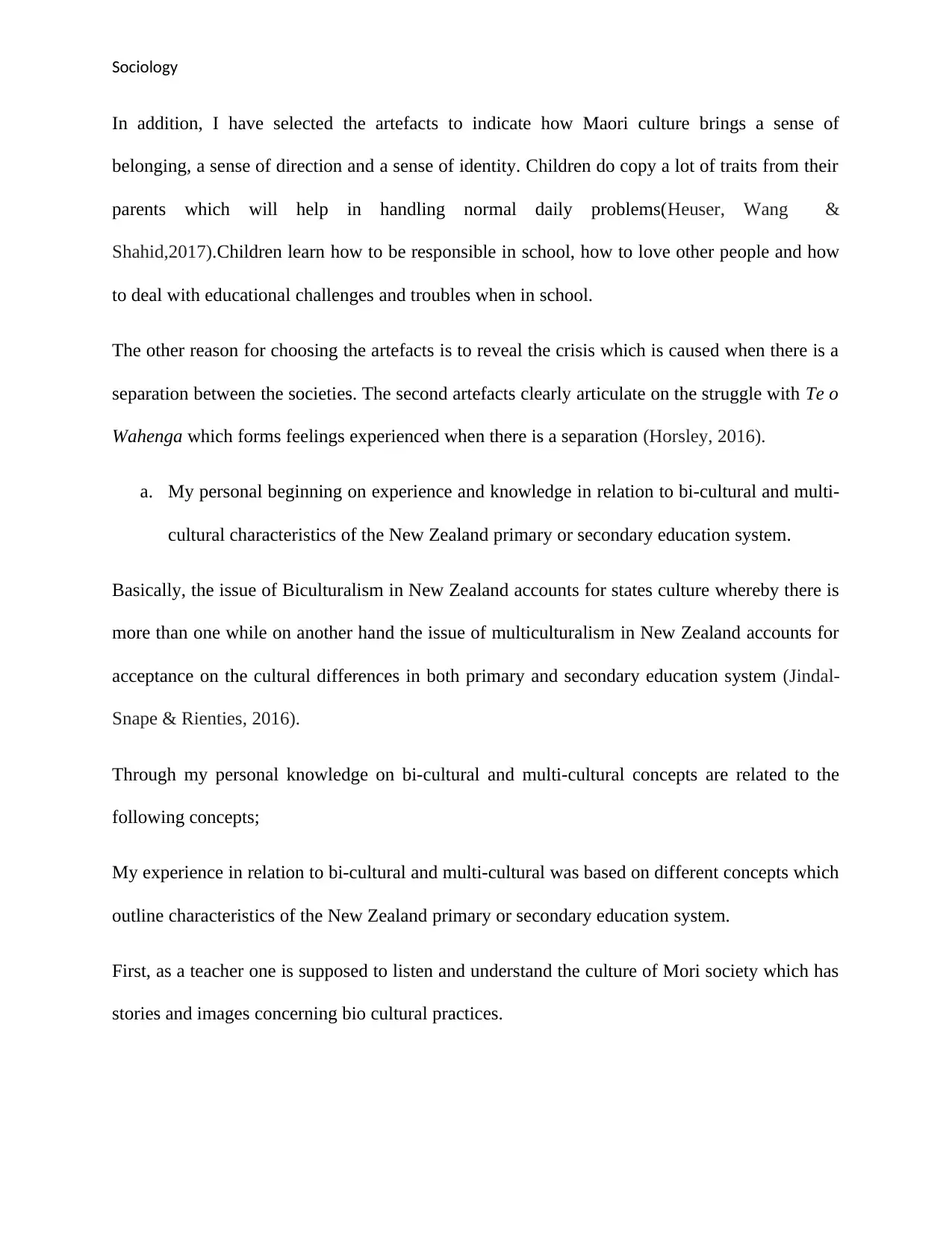
Sociology
In addition, I have selected the artefacts to indicate how Maori culture brings a sense of
belonging, a sense of direction and a sense of identity. Children do copy a lot of traits from their
parents which will help in handling normal daily problems(Heuser, Wang &
Shahid,2017).Children learn how to be responsible in school, how to love other people and how
to deal with educational challenges and troubles when in school.
The other reason for choosing the artefacts is to reveal the crisis which is caused when there is a
separation between the societies. The second artefacts clearly articulate on the struggle with Te o
Wahenga which forms feelings experienced when there is a separation (Horsley, 2016).
a. My personal beginning on experience and knowledge in relation to bi-cultural and multi-
cultural characteristics of the New Zealand primary or secondary education system.
Basically, the issue of Biculturalism in New Zealand accounts for states culture whereby there is
more than one while on another hand the issue of multiculturalism in New Zealand accounts for
acceptance on the cultural differences in both primary and secondary education system (Jindal-
Snape & Rienties, 2016).
Through my personal knowledge on bi-cultural and multi-cultural concepts are related to the
following concepts;
My experience in relation to bi-cultural and multi-cultural was based on different concepts which
outline characteristics of the New Zealand primary or secondary education system.
First, as a teacher one is supposed to listen and understand the culture of Mori society which has
stories and images concerning bio cultural practices.
In addition, I have selected the artefacts to indicate how Maori culture brings a sense of
belonging, a sense of direction and a sense of identity. Children do copy a lot of traits from their
parents which will help in handling normal daily problems(Heuser, Wang &
Shahid,2017).Children learn how to be responsible in school, how to love other people and how
to deal with educational challenges and troubles when in school.
The other reason for choosing the artefacts is to reveal the crisis which is caused when there is a
separation between the societies. The second artefacts clearly articulate on the struggle with Te o
Wahenga which forms feelings experienced when there is a separation (Horsley, 2016).
a. My personal beginning on experience and knowledge in relation to bi-cultural and multi-
cultural characteristics of the New Zealand primary or secondary education system.
Basically, the issue of Biculturalism in New Zealand accounts for states culture whereby there is
more than one while on another hand the issue of multiculturalism in New Zealand accounts for
acceptance on the cultural differences in both primary and secondary education system (Jindal-
Snape & Rienties, 2016).
Through my personal knowledge on bi-cultural and multi-cultural concepts are related to the
following concepts;
My experience in relation to bi-cultural and multi-cultural was based on different concepts which
outline characteristics of the New Zealand primary or secondary education system.
First, as a teacher one is supposed to listen and understand the culture of Mori society which has
stories and images concerning bio cultural practices.
Secure Best Marks with AI Grader
Need help grading? Try our AI Grader for instant feedback on your assignments.
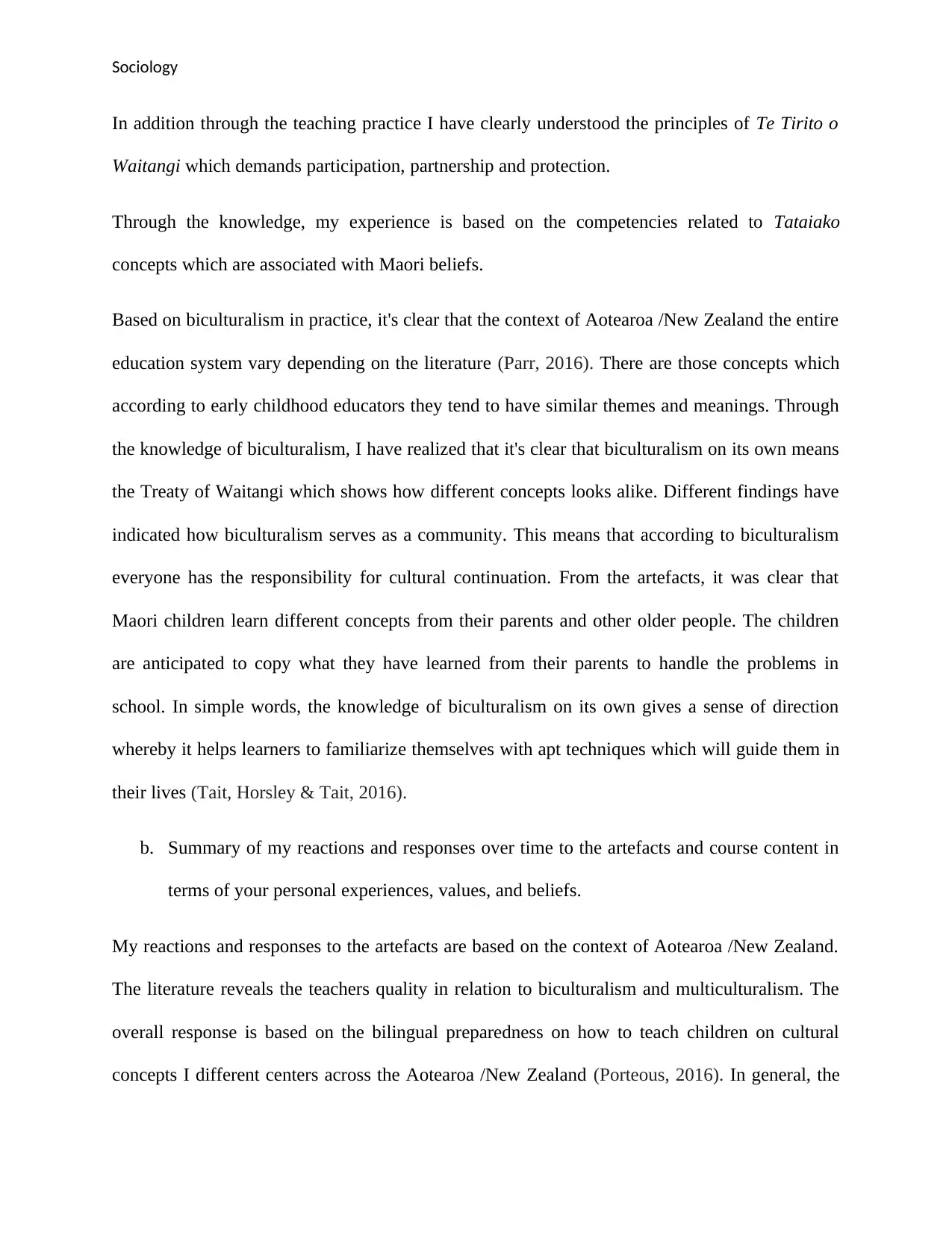
Sociology
In addition through the teaching practice I have clearly understood the principles of Te Tirito o
Waitangi which demands participation, partnership and protection.
Through the knowledge, my experience is based on the competencies related to Tataiako
concepts which are associated with Maori beliefs.
Based on biculturalism in practice, it's clear that the context of Aotearoa /New Zealand the entire
education system vary depending on the literature (Parr, 2016). There are those concepts which
according to early childhood educators they tend to have similar themes and meanings. Through
the knowledge of biculturalism, I have realized that it's clear that biculturalism on its own means
the Treaty of Waitangi which shows how different concepts looks alike. Different findings have
indicated how biculturalism serves as a community. This means that according to biculturalism
everyone has the responsibility for cultural continuation. From the artefacts, it was clear that
Maori children learn different concepts from their parents and other older people. The children
are anticipated to copy what they have learned from their parents to handle the problems in
school. In simple words, the knowledge of biculturalism on its own gives a sense of direction
whereby it helps learners to familiarize themselves with apt techniques which will guide them in
their lives (Tait, Horsley & Tait, 2016).
b. Summary of my reactions and responses over time to the artefacts and course content in
terms of your personal experiences, values, and beliefs.
My reactions and responses to the artefacts are based on the context of Aotearoa /New Zealand.
The literature reveals the teachers quality in relation to biculturalism and multiculturalism. The
overall response is based on the bilingual preparedness on how to teach children on cultural
concepts I different centers across the Aotearoa /New Zealand (Porteous, 2016). In general, the
In addition through the teaching practice I have clearly understood the principles of Te Tirito o
Waitangi which demands participation, partnership and protection.
Through the knowledge, my experience is based on the competencies related to Tataiako
concepts which are associated with Maori beliefs.
Based on biculturalism in practice, it's clear that the context of Aotearoa /New Zealand the entire
education system vary depending on the literature (Parr, 2016). There are those concepts which
according to early childhood educators they tend to have similar themes and meanings. Through
the knowledge of biculturalism, I have realized that it's clear that biculturalism on its own means
the Treaty of Waitangi which shows how different concepts looks alike. Different findings have
indicated how biculturalism serves as a community. This means that according to biculturalism
everyone has the responsibility for cultural continuation. From the artefacts, it was clear that
Maori children learn different concepts from their parents and other older people. The children
are anticipated to copy what they have learned from their parents to handle the problems in
school. In simple words, the knowledge of biculturalism on its own gives a sense of direction
whereby it helps learners to familiarize themselves with apt techniques which will guide them in
their lives (Tait, Horsley & Tait, 2016).
b. Summary of my reactions and responses over time to the artefacts and course content in
terms of your personal experiences, values, and beliefs.
My reactions and responses to the artefacts are based on the context of Aotearoa /New Zealand.
The literature reveals the teachers quality in relation to biculturalism and multiculturalism. The
overall response is based on the bilingual preparedness on how to teach children on cultural
concepts I different centers across the Aotearoa /New Zealand (Porteous, 2016). In general, the
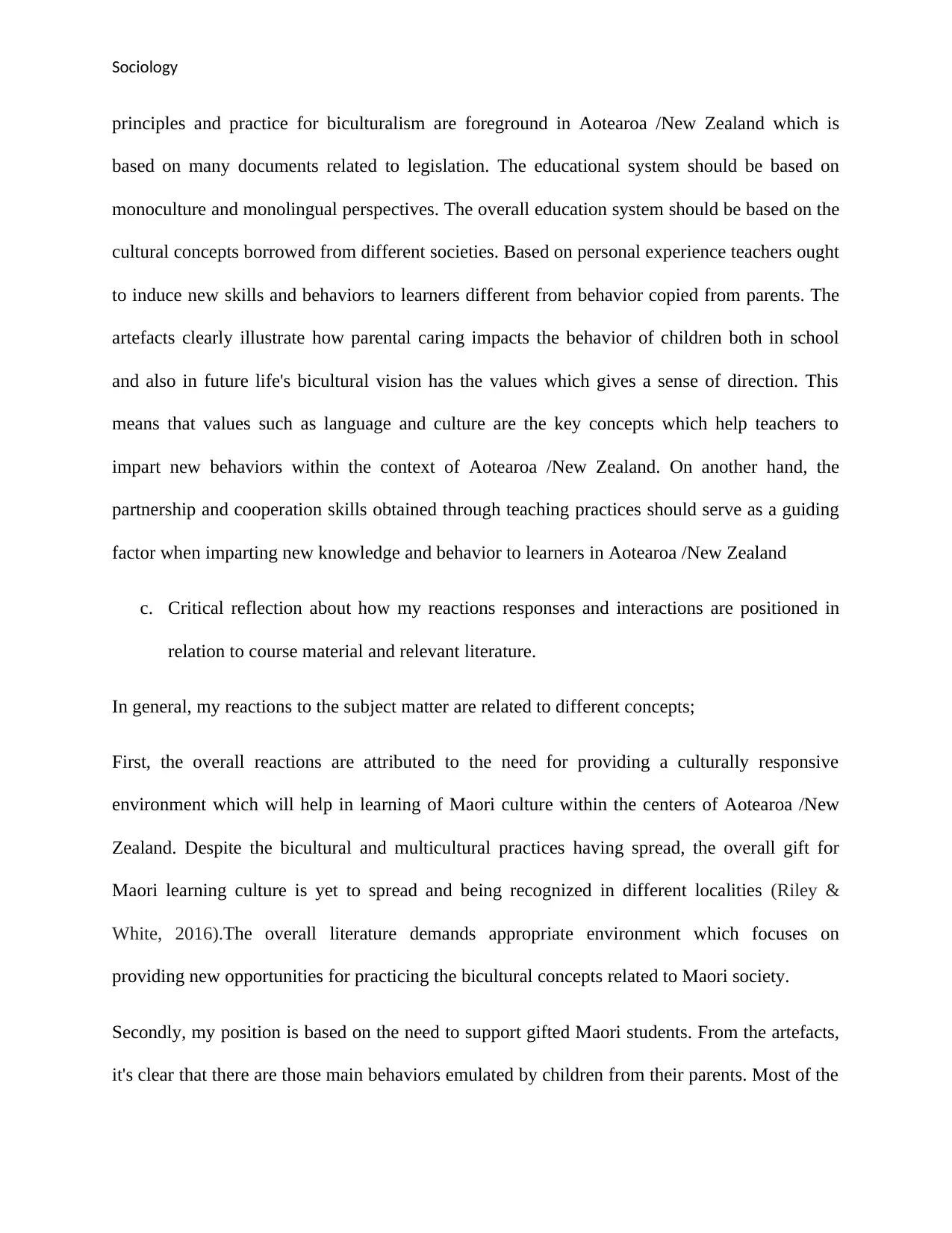
Sociology
principles and practice for biculturalism are foreground in Aotearoa /New Zealand which is
based on many documents related to legislation. The educational system should be based on
monoculture and monolingual perspectives. The overall education system should be based on the
cultural concepts borrowed from different societies. Based on personal experience teachers ought
to induce new skills and behaviors to learners different from behavior copied from parents. The
artefacts clearly illustrate how parental caring impacts the behavior of children both in school
and also in future life's bicultural vision has the values which gives a sense of direction. This
means that values such as language and culture are the key concepts which help teachers to
impart new behaviors within the context of Aotearoa /New Zealand. On another hand, the
partnership and cooperation skills obtained through teaching practices should serve as a guiding
factor when imparting new knowledge and behavior to learners in Aotearoa /New Zealand
c. Critical reflection about how my reactions responses and interactions are positioned in
relation to course material and relevant literature.
In general, my reactions to the subject matter are related to different concepts;
First, the overall reactions are attributed to the need for providing a culturally responsive
environment which will help in learning of Maori culture within the centers of Aotearoa /New
Zealand. Despite the bicultural and multicultural practices having spread, the overall gift for
Maori learning culture is yet to spread and being recognized in different localities (Riley &
White, 2016).The overall literature demands appropriate environment which focuses on
providing new opportunities for practicing the bicultural concepts related to Maori society.
Secondly, my position is based on the need to support gifted Maori students. From the artefacts,
it's clear that there are those main behaviors emulated by children from their parents. Most of the
principles and practice for biculturalism are foreground in Aotearoa /New Zealand which is
based on many documents related to legislation. The educational system should be based on
monoculture and monolingual perspectives. The overall education system should be based on the
cultural concepts borrowed from different societies. Based on personal experience teachers ought
to induce new skills and behaviors to learners different from behavior copied from parents. The
artefacts clearly illustrate how parental caring impacts the behavior of children both in school
and also in future life's bicultural vision has the values which gives a sense of direction. This
means that values such as language and culture are the key concepts which help teachers to
impart new behaviors within the context of Aotearoa /New Zealand. On another hand, the
partnership and cooperation skills obtained through teaching practices should serve as a guiding
factor when imparting new knowledge and behavior to learners in Aotearoa /New Zealand
c. Critical reflection about how my reactions responses and interactions are positioned in
relation to course material and relevant literature.
In general, my reactions to the subject matter are related to different concepts;
First, the overall reactions are attributed to the need for providing a culturally responsive
environment which will help in learning of Maori culture within the centers of Aotearoa /New
Zealand. Despite the bicultural and multicultural practices having spread, the overall gift for
Maori learning culture is yet to spread and being recognized in different localities (Riley &
White, 2016).The overall literature demands appropriate environment which focuses on
providing new opportunities for practicing the bicultural concepts related to Maori society.
Secondly, my position is based on the need to support gifted Maori students. From the artefacts,
it's clear that there are those main behaviors emulated by children from their parents. Most of the
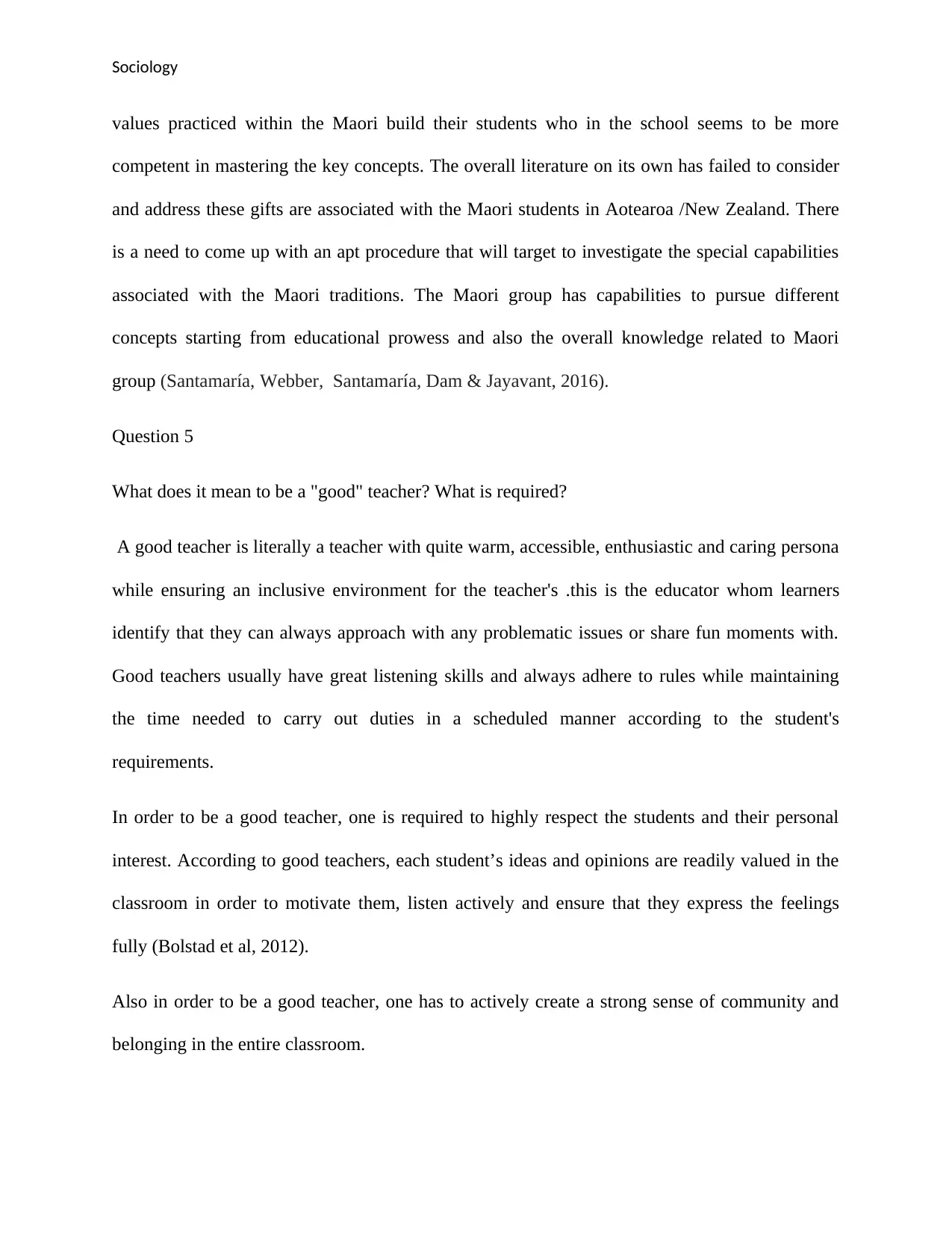
Sociology
values practiced within the Maori build their students who in the school seems to be more
competent in mastering the key concepts. The overall literature on its own has failed to consider
and address these gifts are associated with the Maori students in Aotearoa /New Zealand. There
is a need to come up with an apt procedure that will target to investigate the special capabilities
associated with the Maori traditions. The Maori group has capabilities to pursue different
concepts starting from educational prowess and also the overall knowledge related to Maori
group (Santamaría, Webber, Santamaría, Dam & Jayavant, 2016).
Question 5
What does it mean to be a "good" teacher? What is required?
A good teacher is literally a teacher with quite warm, accessible, enthusiastic and caring persona
while ensuring an inclusive environment for the teacher's .this is the educator whom learners
identify that they can always approach with any problematic issues or share fun moments with.
Good teachers usually have great listening skills and always adhere to rules while maintaining
the time needed to carry out duties in a scheduled manner according to the student's
requirements.
In order to be a good teacher, one is required to highly respect the students and their personal
interest. According to good teachers, each student’s ideas and opinions are readily valued in the
classroom in order to motivate them, listen actively and ensure that they express the feelings
fully (Bolstad et al, 2012).
Also in order to be a good teacher, one has to actively create a strong sense of community and
belonging in the entire classroom.
values practiced within the Maori build their students who in the school seems to be more
competent in mastering the key concepts. The overall literature on its own has failed to consider
and address these gifts are associated with the Maori students in Aotearoa /New Zealand. There
is a need to come up with an apt procedure that will target to investigate the special capabilities
associated with the Maori traditions. The Maori group has capabilities to pursue different
concepts starting from educational prowess and also the overall knowledge related to Maori
group (Santamaría, Webber, Santamaría, Dam & Jayavant, 2016).
Question 5
What does it mean to be a "good" teacher? What is required?
A good teacher is literally a teacher with quite warm, accessible, enthusiastic and caring persona
while ensuring an inclusive environment for the teacher's .this is the educator whom learners
identify that they can always approach with any problematic issues or share fun moments with.
Good teachers usually have great listening skills and always adhere to rules while maintaining
the time needed to carry out duties in a scheduled manner according to the student's
requirements.
In order to be a good teacher, one is required to highly respect the students and their personal
interest. According to good teachers, each student’s ideas and opinions are readily valued in the
classroom in order to motivate them, listen actively and ensure that they express the feelings
fully (Bolstad et al, 2012).
Also in order to be a good teacher, one has to actively create a strong sense of community and
belonging in the entire classroom.
Paraphrase This Document
Need a fresh take? Get an instant paraphrase of this document with our AI Paraphraser

Sociology
A good teacher also requires to be highly skilled and disciplined in order to promote good
behavior in students. A good teacher also need to set maximum expectations for all the students
so that the achievement of students on academic level can be promoted. A good teacher requires
to set classroom rules and rein force school policies in a consistent manner so that children
dignity can be extended.
A good teacher respects the diversity in student's talents as a way of learning and also issues out
optimum opportunities for interaction, encourage effective communication and motivate the
students and other teachers.
What part do culture and identity play in teaching and learning?
Various cultural practices usually affect the manner in which students actively participate in
education. Culture enables teachers to engage students actively in the learning process by
identifying the values and backgrounds in disciplines and fields like grouping them according to
their academic capabilities. They do not rely on racial and ethnic prejudices hence ensures that
they boost the students experiences (Cody, 2016). Culture promotes diversity in the classroom in
terms of language and communication.in this way learners learn different languages and interact
with students from other cultural groups hence exposing them to the outside world.in this way
diversity is enhanced making students build strong relationships. Teachers also, in this case,
ensure that the classroom is socially inclusive.
Culture is a strong part of students' lives as it enhances ethical issues to be maintained. Views,
values, loyalties maintained improves attitude and perspective of students towards learning
Identity play creates a strong sense of exclusivity and connectivity in students. They are able to
identify their ability and understanding of their personal skills in learning. Identity play improves
A good teacher also requires to be highly skilled and disciplined in order to promote good
behavior in students. A good teacher also need to set maximum expectations for all the students
so that the achievement of students on academic level can be promoted. A good teacher requires
to set classroom rules and rein force school policies in a consistent manner so that children
dignity can be extended.
A good teacher respects the diversity in student's talents as a way of learning and also issues out
optimum opportunities for interaction, encourage effective communication and motivate the
students and other teachers.
What part do culture and identity play in teaching and learning?
Various cultural practices usually affect the manner in which students actively participate in
education. Culture enables teachers to engage students actively in the learning process by
identifying the values and backgrounds in disciplines and fields like grouping them according to
their academic capabilities. They do not rely on racial and ethnic prejudices hence ensures that
they boost the students experiences (Cody, 2016). Culture promotes diversity in the classroom in
terms of language and communication.in this way learners learn different languages and interact
with students from other cultural groups hence exposing them to the outside world.in this way
diversity is enhanced making students build strong relationships. Teachers also, in this case,
ensure that the classroom is socially inclusive.
Culture is a strong part of students' lives as it enhances ethical issues to be maintained. Views,
values, loyalties maintained improves attitude and perspective of students towards learning
Identity play creates a strong sense of exclusivity and connectivity in students. They are able to
identify their ability and understanding of their personal skills in learning. Identity play improves

Sociology
their cognitive and physical development (Durie 2005). This makes them have full capacity to
identify themselves with other groups hence promoting discussion forums in classrooms. They
are able to effectively communicate with each other, interact and exchange basic ideas. They also
adapt to the learning environment quite easily and understands issues such as respect for personal
interest, insights, and gender-based issues.
What kinds of environments promote learning?
A welcoming learning environment is always best for learning. A collaborative and supportive
environment also promoting learning when teachers create mutual respect in the entire
classroom.
Some of the required learning environment that is quite beneficial in learning is the learner
centered, knowledge, assessment and community-centered ones.
What part do/should whānau play in students' learning?
Whānau is great play in children's education. They play a huge role in assisting the young
learners to feel positive about education and going to school each day to be able to learn
efficiently .they also play a huge role in enabling educators to clearly understand the children
that they are teaching hence imparting both knowledge and skills (Lai 2011). They engage
actively in order to ensure that students understand the learning process and their motivation
towards learning.
In New Zealand, they are able to raise the achievement and support the learning of tamariki and
rangathi as the school, focus on a cultural account incorporated in the curriculum.
their cognitive and physical development (Durie 2005). This makes them have full capacity to
identify themselves with other groups hence promoting discussion forums in classrooms. They
are able to effectively communicate with each other, interact and exchange basic ideas. They also
adapt to the learning environment quite easily and understands issues such as respect for personal
interest, insights, and gender-based issues.
What kinds of environments promote learning?
A welcoming learning environment is always best for learning. A collaborative and supportive
environment also promoting learning when teachers create mutual respect in the entire
classroom.
Some of the required learning environment that is quite beneficial in learning is the learner
centered, knowledge, assessment and community-centered ones.
What part do/should whānau play in students' learning?
Whānau is great play in children's education. They play a huge role in assisting the young
learners to feel positive about education and going to school each day to be able to learn
efficiently .they also play a huge role in enabling educators to clearly understand the children
that they are teaching hence imparting both knowledge and skills (Lai 2011). They engage
actively in order to ensure that students understand the learning process and their motivation
towards learning.
In New Zealand, they are able to raise the achievement and support the learning of tamariki and
rangathi as the school, focus on a cultural account incorporated in the curriculum.

Sociology
Considering your personal values and beliefs: How have they been affirmed by what you have
learned? How have they been challenged?
My personal beliefs and value have been greatly encouraged and supported emotionally since I
have been able to acquire more knowledge and understanding through learning the diverse
cultures of new Zealand.my beliefs regarding the role of culture in New Zealand's learning have
also been supported by acknowledging the efforts undertaken by both students and teachers in
maintain and respecting the diverse cultures (Murray, Gao & Lamb, 2011). I am able to
effectively communicate my feelings and understand my personal identity more. My personal
values and beliefs have diversified and this has enabled me to have a great attitude and highly
motivated in interacting with cultural diversity in schools.it has promoted moral and ethical
behaviors.
However, they have also been challenged since I have acknowledged that before acquiring what
I have learned I had minimal skills and opportunities. The knowledge gained have challenged my
personal beliefs and values since I have identified that I need to do great efforts in increasing my
level of personal attributes.
How have they changed?
They have changed a great deal since I have been able to incorporate new values and beliefs
borrowing some from a particular culture. My level of interaction, communication of ideas and
behavior have improved.
What has influenced your emerging philosophy (e.g. life experiences, mentors, teachers,
academic learning)?
Considering your personal values and beliefs: How have they been affirmed by what you have
learned? How have they been challenged?
My personal beliefs and value have been greatly encouraged and supported emotionally since I
have been able to acquire more knowledge and understanding through learning the diverse
cultures of new Zealand.my beliefs regarding the role of culture in New Zealand's learning have
also been supported by acknowledging the efforts undertaken by both students and teachers in
maintain and respecting the diverse cultures (Murray, Gao & Lamb, 2011). I am able to
effectively communicate my feelings and understand my personal identity more. My personal
values and beliefs have diversified and this has enabled me to have a great attitude and highly
motivated in interacting with cultural diversity in schools.it has promoted moral and ethical
behaviors.
However, they have also been challenged since I have acknowledged that before acquiring what
I have learned I had minimal skills and opportunities. The knowledge gained have challenged my
personal beliefs and values since I have identified that I need to do great efforts in increasing my
level of personal attributes.
How have they changed?
They have changed a great deal since I have been able to incorporate new values and beliefs
borrowing some from a particular culture. My level of interaction, communication of ideas and
behavior have improved.
What has influenced your emerging philosophy (e.g. life experiences, mentors, teachers,
academic learning)?
Secure Best Marks with AI Grader
Need help grading? Try our AI Grader for instant feedback on your assignments.

Sociology
Life experiences such as interacting with diverse students and teachers in the classroom have
positively impacted on my learning philosophy like cultural imagery.
I have also interacted with good teachers and mentors who have influenced my behavioral
philosophy in understanding the learning environment better.
6. thinking about your emerging philosophy, identify three goals for practicums two and
three and justify why these are important for you to work towards.
In regard to behaviorism merging philosophy, the following goals are important in education.
Focusing on student-centered learning such as Decision-making goals
The merging behaviorism philosophy mainly focuses on students' abilities, personal interests,
values and behaviors and how they are utilized in decision and critical thinking skills.it is
important to work on these goals in order to make sure that each student is able to interact and
also for the teacher to understand the personal life of a certain students (Mutch, & Collins, 2012).
Identifying personal and cultural needs, teacher's perspective will be improved towards students
hence creating socially inclusive teaching and learning environment.
Promoting positive attitudes to learning
Life experiences such as interacting with diverse students and teachers in the classroom have
positively impacted on my learning philosophy like cultural imagery.
I have also interacted with good teachers and mentors who have influenced my behavioral
philosophy in understanding the learning environment better.
6. thinking about your emerging philosophy, identify three goals for practicums two and
three and justify why these are important for you to work towards.
In regard to behaviorism merging philosophy, the following goals are important in education.
Focusing on student-centered learning such as Decision-making goals
The merging behaviorism philosophy mainly focuses on students' abilities, personal interests,
values and behaviors and how they are utilized in decision and critical thinking skills.it is
important to work on these goals in order to make sure that each student is able to interact and
also for the teacher to understand the personal life of a certain students (Mutch, & Collins, 2012).
Identifying personal and cultural needs, teacher's perspective will be improved towards students
hence creating socially inclusive teaching and learning environment.
Promoting positive attitudes to learning
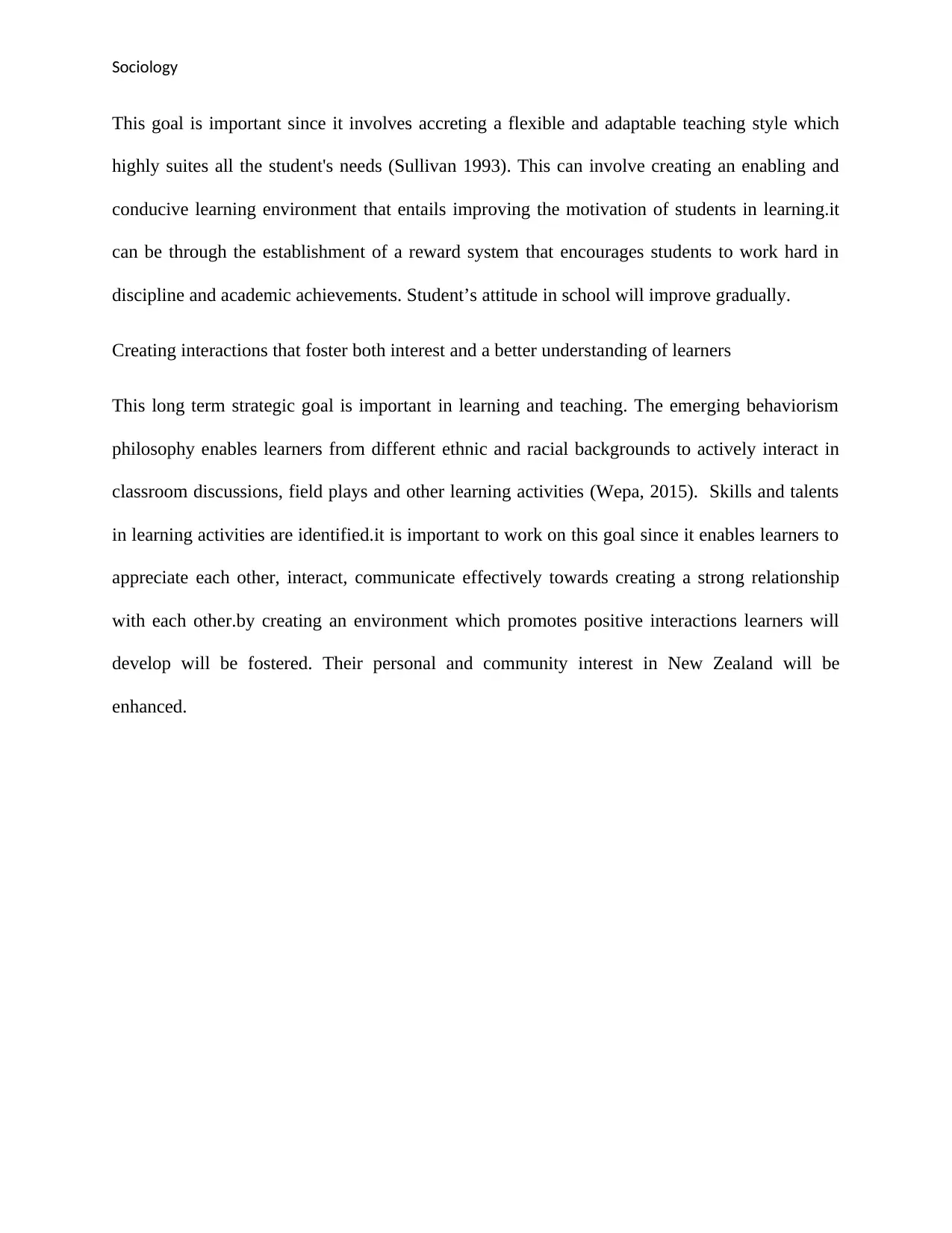
Sociology
This goal is important since it involves accreting a flexible and adaptable teaching style which
highly suites all the student's needs (Sullivan 1993). This can involve creating an enabling and
conducive learning environment that entails improving the motivation of students in learning.it
can be through the establishment of a reward system that encourages students to work hard in
discipline and academic achievements. Student’s attitude in school will improve gradually.
Creating interactions that foster both interest and a better understanding of learners
This long term strategic goal is important in learning and teaching. The emerging behaviorism
philosophy enables learners from different ethnic and racial backgrounds to actively interact in
classroom discussions, field plays and other learning activities (Wepa, 2015). Skills and talents
in learning activities are identified.it is important to work on this goal since it enables learners to
appreciate each other, interact, communicate effectively towards creating a strong relationship
with each other.by creating an environment which promotes positive interactions learners will
develop will be fostered. Their personal and community interest in New Zealand will be
enhanced.
This goal is important since it involves accreting a flexible and adaptable teaching style which
highly suites all the student's needs (Sullivan 1993). This can involve creating an enabling and
conducive learning environment that entails improving the motivation of students in learning.it
can be through the establishment of a reward system that encourages students to work hard in
discipline and academic achievements. Student’s attitude in school will improve gradually.
Creating interactions that foster both interest and a better understanding of learners
This long term strategic goal is important in learning and teaching. The emerging behaviorism
philosophy enables learners from different ethnic and racial backgrounds to actively interact in
classroom discussions, field plays and other learning activities (Wepa, 2015). Skills and talents
in learning activities are identified.it is important to work on this goal since it enables learners to
appreciate each other, interact, communicate effectively towards creating a strong relationship
with each other.by creating an environment which promotes positive interactions learners will
develop will be fostered. Their personal and community interest in New Zealand will be
enhanced.
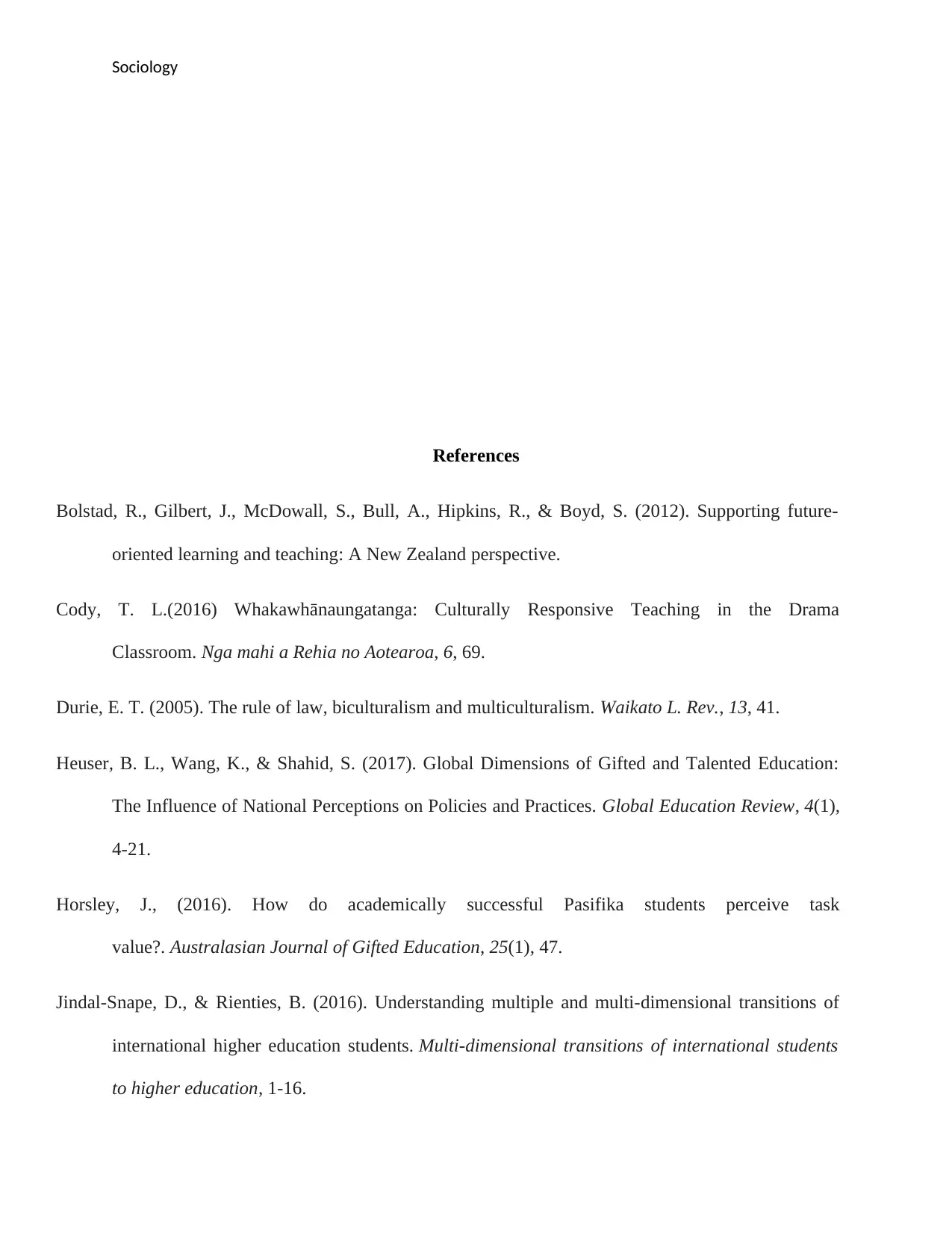
Sociology
References
Bolstad, R., Gilbert, J., McDowall, S., Bull, A., Hipkins, R., & Boyd, S. (2012). Supporting future-
oriented learning and teaching: A New Zealand perspective.
Cody, T. L.(2016) Whakawhānaungatanga: Culturally Responsive Teaching in the Drama
Classroom. Nga mahi a Rehia no Aotearoa, 6, 69.
Durie, E. T. (2005). The rule of law, biculturalism and multiculturalism. Waikato L. Rev., 13, 41.
Heuser, B. L., Wang, K., & Shahid, S. (2017). Global Dimensions of Gifted and Talented Education:
The Influence of National Perceptions on Policies and Practices. Global Education Review, 4(1),
4-21.
Horsley, J., (2016). How do academically successful Pasifika students perceive task
value?. Australasian Journal of Gifted Education, 25(1), 47.
Jindal-Snape, D., & Rienties, B. (2016). Understanding multiple and multi-dimensional transitions of
international higher education students. Multi-dimensional transitions of international students
to higher education, 1-16.
References
Bolstad, R., Gilbert, J., McDowall, S., Bull, A., Hipkins, R., & Boyd, S. (2012). Supporting future-
oriented learning and teaching: A New Zealand perspective.
Cody, T. L.(2016) Whakawhānaungatanga: Culturally Responsive Teaching in the Drama
Classroom. Nga mahi a Rehia no Aotearoa, 6, 69.
Durie, E. T. (2005). The rule of law, biculturalism and multiculturalism. Waikato L. Rev., 13, 41.
Heuser, B. L., Wang, K., & Shahid, S. (2017). Global Dimensions of Gifted and Talented Education:
The Influence of National Perceptions on Policies and Practices. Global Education Review, 4(1),
4-21.
Horsley, J., (2016). How do academically successful Pasifika students perceive task
value?. Australasian Journal of Gifted Education, 25(1), 47.
Jindal-Snape, D., & Rienties, B. (2016). Understanding multiple and multi-dimensional transitions of
international higher education students. Multi-dimensional transitions of international students
to higher education, 1-16.
Paraphrase This Document
Need a fresh take? Get an instant paraphrase of this document with our AI Paraphraser
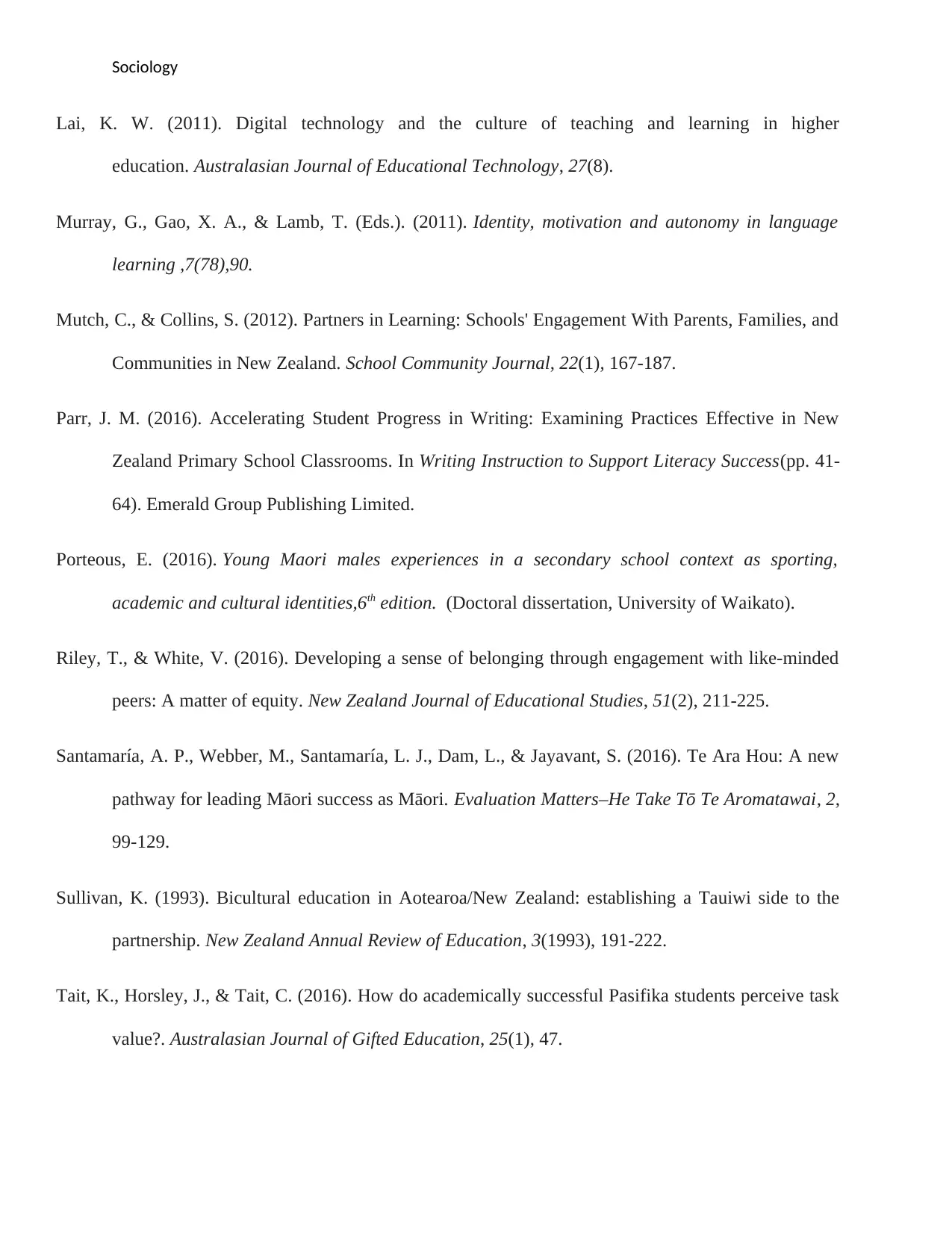
Sociology
Lai, K. W. (2011). Digital technology and the culture of teaching and learning in higher
education. Australasian Journal of Educational Technology, 27(8).
Murray, G., Gao, X. A., & Lamb, T. (Eds.). (2011). Identity, motivation and autonomy in language
learning ,7(78),90.
Mutch, C., & Collins, S. (2012). Partners in Learning: Schools' Engagement With Parents, Families, and
Communities in New Zealand. School Community Journal, 22(1), 167-187.
Parr, J. M. (2016). Accelerating Student Progress in Writing: Examining Practices Effective in New
Zealand Primary School Classrooms. In Writing Instruction to Support Literacy Success(pp. 41-
64). Emerald Group Publishing Limited.
Porteous, E. (2016). Young Maori males experiences in a secondary school context as sporting,
academic and cultural identities,6th edition. (Doctoral dissertation, University of Waikato).
Riley, T., & White, V. (2016). Developing a sense of belonging through engagement with like-minded
peers: A matter of equity. New Zealand Journal of Educational Studies, 51(2), 211-225.
Santamaría, A. P., Webber, M., Santamaría, L. J., Dam, L., & Jayavant, S. (2016). Te Ara Hou: A new
pathway for leading Māori success as Māori. Evaluation Matters–He Take Tō Te Aromatawai, 2,
99-129.
Sullivan, K. (1993). Bicultural education in Aotearoa/New Zealand: establishing a Tauiwi side to the
partnership. New Zealand Annual Review of Education, 3(1993), 191-222.
Tait, K., Horsley, J., & Tait, C. (2016). How do academically successful Pasifika students perceive task
value?. Australasian Journal of Gifted Education, 25(1), 47.
Lai, K. W. (2011). Digital technology and the culture of teaching and learning in higher
education. Australasian Journal of Educational Technology, 27(8).
Murray, G., Gao, X. A., & Lamb, T. (Eds.). (2011). Identity, motivation and autonomy in language
learning ,7(78),90.
Mutch, C., & Collins, S. (2012). Partners in Learning: Schools' Engagement With Parents, Families, and
Communities in New Zealand. School Community Journal, 22(1), 167-187.
Parr, J. M. (2016). Accelerating Student Progress in Writing: Examining Practices Effective in New
Zealand Primary School Classrooms. In Writing Instruction to Support Literacy Success(pp. 41-
64). Emerald Group Publishing Limited.
Porteous, E. (2016). Young Maori males experiences in a secondary school context as sporting,
academic and cultural identities,6th edition. (Doctoral dissertation, University of Waikato).
Riley, T., & White, V. (2016). Developing a sense of belonging through engagement with like-minded
peers: A matter of equity. New Zealand Journal of Educational Studies, 51(2), 211-225.
Santamaría, A. P., Webber, M., Santamaría, L. J., Dam, L., & Jayavant, S. (2016). Te Ara Hou: A new
pathway for leading Māori success as Māori. Evaluation Matters–He Take Tō Te Aromatawai, 2,
99-129.
Sullivan, K. (1993). Bicultural education in Aotearoa/New Zealand: establishing a Tauiwi side to the
partnership. New Zealand Annual Review of Education, 3(1993), 191-222.
Tait, K., Horsley, J., & Tait, C. (2016). How do academically successful Pasifika students perceive task
value?. Australasian Journal of Gifted Education, 25(1), 47.

Sociology
Wepa, D. (Ed.). (2015). Cultural safety in Aotearoa New Zealand ,7th edition. Cambridge University
Press.
Wepa, D. (Ed.). (2015). Cultural safety in Aotearoa New Zealand ,7th edition. Cambridge University
Press.
1 out of 15
Your All-in-One AI-Powered Toolkit for Academic Success.
+13062052269
info@desklib.com
Available 24*7 on WhatsApp / Email
![[object Object]](/_next/static/media/star-bottom.7253800d.svg)
Unlock your academic potential
© 2024 | Zucol Services PVT LTD | All rights reserved.